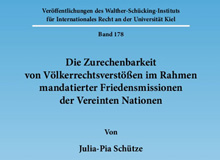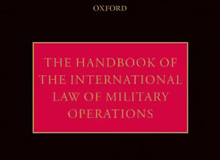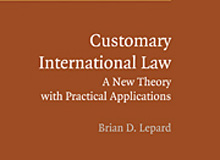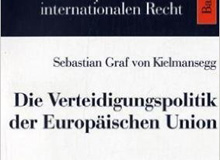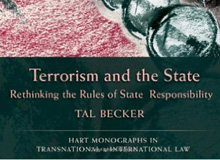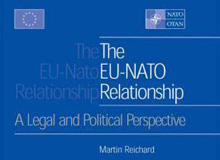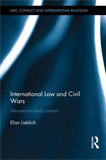
International Law and Civil Wars: Intervention and Consent. Eliav Lieblich. London and New York: Routledge. 2013. 286pp. £80. ISBN 978-0-415-50790-5.
Foreign military intervention into internal armed conflicts is a long-standing practice in international relations, yet its legality is fraught with doubt. A broad consensus exists only on one fundamental point: outside intervention in situations of civil strife is not permissible under international law—as it contradicts the principle of non-intervention, the prohibition of the use of force and, depending on the circumstances, the right of self-determination—unless it can be justified with reference to a valid exception. Beyond this point, any consensus concerning the legality of foreign military intervention is precarious at best. While the majority view accepts that intervention is permissible, in principle and subject to limitations, if it takes place with the consent of the local government,1 a minority maintains that the government of a State embroiled in a civil war cannot validly invite foreign assistance under any circumstances.2 According to this minority view, consent does not constitute an exception to the general prohibition of military intervention during the course of an internal conflict. However, if we accept with the majority that consent is capable of justifying military intervention during civil strife, a host of difficulties still arise. Who can give consent? In what form and when should it be expressed? Are there any limits to the authority of inviting foreign intervention? Can this authority be lost? Under what circumstances can consent be revoked and by whom?
The goal of International Law and Civil Wars: Intervention and Consent by Eliav Lieblich is to clarify some of these questions by investigating the nature and limitations of government consent as an exception to the prohibition of foreign military intervention in situations of internal armed conflict. By addressing a topic which has received a fair amount of attention in the past and which continues to attract considerable interest today, Lieblich embarks on a path that is already well beaten. Readers interested in the subject will no doubt recall Georg Nolte’s magisterial Eingreifen auf Einladung. Providing a comprehensive assessment of foreign military interventions at the invitation of the local government in over six hundred pages, Professor Nolte’s contribution to the field is a hard act to follow. What can International Law and Civil Wars add? Quite a bit, it turns out. Published in 1999, Nolte’s Eingreifen auf Einladung offered the first systematic assessment of international practice following the end of the Cold War. One of that book’s principal merits was that it revisited past academic opinion and State practice in the light of the turbulent developments of the early and mid-1990s. However, history did not come to a standstill in 1999. Over the course of the last decade or so, several notable interventions have taken place, including those in Kosovo, Afghanistan, Iraq and Mali. More than anything, these recent cases illustrate the growing legal complexity of contemporary military interventions. Not only do consensual interventions often follow a non-consensual phase of foreign involvement, but consent more often than not complements other legal bases, in particular enforcement action taken under Chapter VII of the UN Charter. Indeed, we seem to be witnessing greater reliance on consent as an element in the implementation of Chapter VII. During this period, we have also seen important normative developments, such as the emergence of the responsibility to protect principle. Although responsibility to protect does not constitute a new exception to the prohibition of the use of force in so far as it is premised on the notion that primary responsibility for international peace and security remains with the Security Council, the intervention in Libya nonetheless shows that it can provide a fresh vocabulary and justification for collective enforcement action. Whereas Eingreifen auf Einladung provides a comprehensive assessment of international practice up to 1999, the focus of International Law and Civil Wars is primarily on the evolution of these more recent trends. As such, the book develops some of the underlying themes identified in earlier scholarship, confirms that the post-Cold War trends continue to gather speed and puts them into their broader historical context.
The book falls into three main parts. The first three chapters set out to clarify certain key concepts. Chapter 1 defines ‘consensual intervention’ as forceful intervention in an internal armed conflict undertaken, in part or in its entirety, for the benefit of one of the parties in a manner that implies the latter’s consent to the intervention (pp. 12–13). This is an overly broad definition of consent: whether it really is reasonable to presume, as Lieblich suggests, that a party which benefits from outside intervention must have given its consent to that intervention is open to question. Such a presumption reverses the burden of proof: instead of having to demonstrate that it acts with the blessing of the local government, an intervening State would have to prove that its activities have not been condemned by the local authorities. This also stands the principle of non-intervention and the prohibition of the use of force on its head: the presumption must be that the general rule applies unless there is a valid exception, not that a valid exception applies unless the contrary is established. Moreover, from a practical point of view, Lieblich’s presumption would require an intervening State merely to make a reasonable claim that its actions are not entirely motivated by selfish interests. That this standard is open to abuse and incapable of objective verification should be evident. Consequently, strong arguments militate in favour of insisting that consent to foreign military interventions must always be granted in express terms. Chapter 2 focuses on the concepts of intervention and internal armed conflict, while Chapter 3 argues that forcible intervention is subject to ‘normative duality’ in the sense that it is governed both by the principle of non-intervention and by the prohibition of the use of force. While the analytical utility of the concept of ‘normative duality’ seems limited, it does highlight the underlying point that consent may be sufficient for the purposes of complying with one norm but not necessarily the other. For example, the fact that a local government has consented to the presence of foreign forces may render their presence compatible with the prohibition of the use of force, but they may still fall foul of the principle of non-intervention should the nature, extent or duration of their activities exceed the limits of the host State’s consent.
The second part of the book takes a step back and traces the evolution of international practice from the pre-UN Charter era to the present. Chapter 4 examines the role of consent during the period when the right to use armed force was not subject to a general prohibition. Chapter 5 deals with the doctrinal shift towards the prohibition of force during the inter-war years, while Chapter 6 is devoted to the Cold War. Two key developments took place during that period. First, States seemed to turn away from assessing the legality of consensual intervention on the basis of whether the government issuing the invitation was in effective control or not and instead increasingly looked at substantive matters, such as its political persuasion and the manner in which it exercised its authority. Second, while rivalry between the Cold War superpowers prompted renewed calls in the literature for strict abstention from all forms of outside intervention into internal conflicts, this position was not mirrored in State practice, which clearly considered intervention at the request of the local government to be permissible under certain circumstances.
The third part of the book examines what these circumstances are. Chapter 7 develops the idea that in contemporary international law, the legality of forcible intervention at the request of the local government depends to a large extent on the legality of the use of force by the latter. If the local authorities employ force unlawfully, then the use of force by foreign forces is equally unlawful, irrespective of the fact that it benefits from the consent of the local government. From this, Lieblich infers that the existence of an armed conflict is a precondition for the legality of consensual foreign intervention. On one level, Lieblich seems to be making a circular point here: if his analysis is concerned with interventions taking place in the context of an internal armed conflict, then the existence of an armed conflict is already a given, per definitionem. The more interesting question is whether or not the existence of an armed conflict entitles the intervening third States to use lethal force. Lieblich suggests that the answer is yes: once international humanitarian law is applicable, it overrides the stricter standards imposed by international human rights law and entitles third States intervening on the side of the local government to have recourse to lethal force. However, the situation may not be quite so straightforward. On the one hand, human rights treaties do not necessarily defer to international humanitarian law in a uniform manner: compare the reference to ‘arbitrary’ deprivation of life under Article 6(1) of the International Covenant on Civil and Political Rights with the rather different approach taken by Articles 2 and 15 of the European Convention on Human Rights. On the other hand, whilst the jus in bello is agnostic about questions of jus ad bellum, international human rights law is not. Consequently, the existence of an armed conflict would render the use of lethal force permissible under international human rights law only if the latter would fully defer to the jus in bello’s agnosticism regarding the jus ad bellum. But does it really do that?
Chapters 8 and 9 develop the book’s main thesis. Whereas traditionally a government engaged in a civil war was considered to have lost its authority to invite outside help as soon as it was incapable of exercising effective control over the State machinery and its territory, Lieblich argues that this test of effectiveness has now been replaced by a different standard. Today, the dominant factor in assessing whether a government may call for outside intervention is whether or not it offers effective protection to civilians. Lieblich bases this conclusion mainly on the emergence of the responsibility to protect principle. There can be little doubt that the treatment of civilians is a major consideration affecting the international community’s response to calls for military intervention. However, to convincingly establish that this standard has passed into lex lata would have required a more methodological treatment of international practice than that offered by Lieblich, in particular considering how closely considerations of strict legality are intertwined with considerations of legitimacy and policy. Finally, Chapter 10 turns to consider the position of the armed opposition. While the old rule which prohibits intervention on the side of the rebels remains intact, Lieblich shows that responsibility to protect is having an impact here too: the more the rebels fail to respect fundamental human rights standards, the more the international community will regard even an ineffective government as its main interlocutor.
International Law and Civil Wars makes a usefully and timely contribution to the literature. Although die-hard positivists might not be fully convinced that the most recent trends in foreign military intervention have passed into law, Lieblich’s assessment nonetheless convincingly shows the direction in which international practice seems to be evolving. Unfortunately, the book is missing a conclusion. This is as surprising as it is regrettable, for a summary of the main findings could have increased its practical appeal significantly.
Published in (2014) 19 Journal of Conflict and Security Law 381–384.


